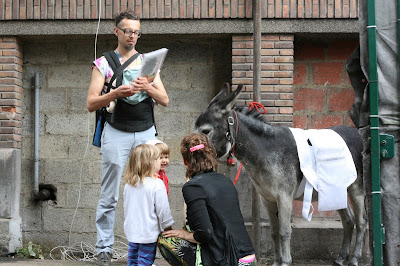 |
| The Magritte Project / Charleroi - Marchienne Au Pont |
Dear
Ms. Aliboni,
For
my contribution to the Hotel Charleroi project, I would like to cooperate with
the ‘Musée des Beaux Arts de Charleroi’. The intervention that I wish to make
consists in the relocation of the René Magritte painting ‘l’éclair’ (1944) from
the museum to a house in Marchienne-au-Pont throughout the course of the Hotel
Charleroi exhibition. From the museum (fig 1), where the painting is usually
displayed, it would move to the living room of a house of a family in
Marchienne-au-Pont that is still to be determined (fig.2). There it would be
kept as a ‘guest’, and displayed to the public. The spot where the painting is
usually exhibited will remain empty throughout the course of the exhibition,
which links the museum to Marchienne-au-Pont and to the Hotel Charleroi
project.
The
choice for the painting of Magritte is not arbitrary. What is striking about
the surrealist works of Magritte is the inconsistencies they create in the way
we can read them. Perhaps the most exemplary is the famous work ‘Ceci n’est pas
une pipe’ that creates a striking discrepancy between word and image. L’éclair
embodies a similar duality. The painting shows a vase with flowers in an
interior, but instead of the flowers, there is a somehow abstract spot of
paint. This ‘blind spot’ as a place that is not occupied, where the imagination
is allowed free scope, plays an important role both in the Hotel Charleroi
project and in the specific intervention that I want to make.
Like
many of my projects, this intervention aims to draw attention to the
environment in which the art work is created or in which it is displayed. By
moving the Magritte painting from the museum to an average living room, I want
to illuminate both places from a new perspective. The functions of the museum
as a place of reference for history and the living room as a place of living in
the here and now become unsettled. The proposed action is not only a symbolic
act, but also demands the collaboration of all the parties involved, including
the museum management and the family members that must take care of the
painting, which for the latter will also involve a real interference in their
living environment. But not only the intimate and institutional scale are being
explored, at the same time the action makes us aware of the broader,
socio-cultural and economic environment of Charleroi and Marchienne-au-Pont.
The painting as a symbol of a city’s cultural and economic wealth, of
possibilities, sensitivity and intelligence is being moved to a place that may
be shaped by other beauty standards, but also by other day-to-day worries, like
making a living, finding a job,…. Many open questions arise, questions about
power, habits, culture, value,…. The surrealist quality of the action makes
free space for utopic thinking as a catalyst for change. As such, the painting
of Magritte is being actualized and new life is being breathed into it. The
mental open space that the action creates is connected to both the content and
the political discourse of Hotel Charleroi, which aims to occupy the abundant
and lost space in and around Charleroi as a place for art/the artist and, from
that point, as a think frame for the future.
Moreover,
I think that my intervention can be a nice and interesting way of putting the
fine arts museum of Charleroi in the spotlights. I visited the museum several
times, and I was pleasantly surprised by the beautiful collection the museum
exhibits. I really think it contains many hidden treasures. Due to my
intervention, the Hotel Charleroi project’s active communication with the press
will also explicitly highlight the museum and the cultural patrimony of
Charleroi.
I
am fully aware of the fact that the project is particularly challenging with
regard to ensuring the safety of the painting and that appropriate measures
must be taken. However, I am confident that we can discuss this and find
satisfactory solutions to this matter. That even in extremely difficult
situations solutions can be found, is exemplified by the 2011 ‘Picasso in
Palestine’ exhibition organised by the International Art Academy Palestine, in
which a masterpiece of Picasso was moved from the Van Abbe Museum to Ramallah,
Palestine and exhibited for the Palestinian people, yet under armed
surveillance (http://blog.frieze.com/picasso-in-palestine/) (fig.3).
Furthermore,
it is not the first time that I have planned projects in unconventional
contexts. For instance, for the ‘Short Cut Leuven’ (2010) project, I took a
group of more than sixty people through Louvain’s city centre along a ‘short
cut’ line, through houses,
gardens, public and private property (fig. 4). This project involved the negotiation
with and cooperation of many public entities and private citizens, and
overcoming many practical difficulties, including safety issues.
Sincerely,
Stijn
Van Dorpe
 |
René Magritte (1898-1967)
L'éclair, (1944)
Coll. MBArts Charleroi - Inv. 1167
Photo. Luc Schrobiltgen
(c) Ch. Herscovici - Sabam Belgium 2013
|